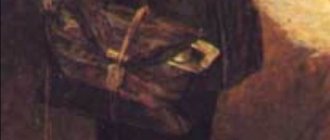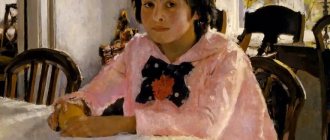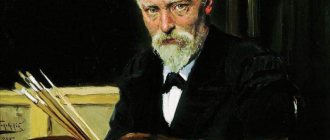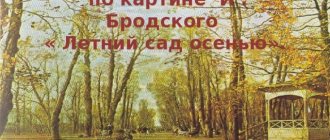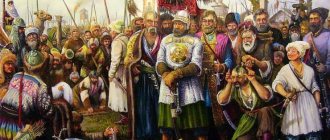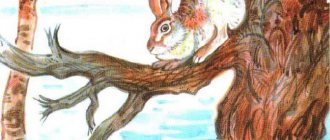Feat of a young Kiev resident essay 5th grade based on a painting
“The Tale of Bygone Years” by Nestor the Chronicler has more than once become a powerful wave of inspiration for various artists.
Among them was A.I. Ivanov. The plot of the film is based on one of the episodes from the chronicle, which tells about the raid on Kiev by the Pechenegs in 968, as well as about a wise and cunning young man who did not spare himself and made his way through the hordes of the enemy and called for help.
The center of the entire composition is filled by a young man. His figure is naked. Against the background of a dark horde, it is depicted in a light image so that the contrast between light and shadow, between feat and villainy, between a young guy and a cloud of Pechenegs can be more strongly felt. There is a spirit of confrontation in the whole picture.
Being a fan of ancient painting, the author emphasizes the beauty of a powerful and strong body. Classic proportions, well-developed muscles, proud head turn.
note
To make the image more tragic, the artist paints the young man barefoot, he is running towards the Dnieper River, and the bridle is tightly clenched in his hands.
From the legend it is known that the guy knows the speech of the Pechenegs, therefore, making his way through the enemy army, he looks for his horse in order to quickly get to his own people and call for help. He plans to swim across the river.
The whole picture expresses struggle and counterbalance. You can see how the young Kiev resident is running, he is already near the river. The Pecheneg lies at his feet, he is dying.
The enemy’s features are depicted with noticeable displeasure and displeasure - his face is dark, his beard is shabby, his cheekbones are wide. And the Kiev resident is the opposite - his facial features are thin, his face is bright and clean, and his forehead is high.
The image of the young man is ennobled by the author in order to further emphasize the significance of his feat, in order to further attract the viewer’s attention to his person.
A little further, in the background, Kyiv, exhausted by sieges, is visible. Its inhabitants stand on the walls, awaiting salvation and liberation.
The scarf around the young man’s neck looks quite symbolic, indicating inevitable losses on the battlefield.
Ivanov A.I. The feat of a young Kiev resident during the siege of Kyiv by the Pechenegs in 968. OK. 1810. Timing
The feat of a young Kiev resident during the siege of Kyiv by the Pechenegs in 968.
Canvas, oil. 204 x 177.5
State Russian Museum
The plot of the picture was one of the heroic episodes of the ancient chronicle. In 968, when the army of Prince Svyatoslav was on a long campaign, the nomadic Pechenegs besieged Kyiv. The hero of the picture is an unknown young Kiev resident.
Knowing the Pecheneg language, he walked through the enemy camp with a bridle in his hands. When his enemies called out to him, the young man replied that he was looking for a runaway horse.
Having crossed the Dnieper, he found a Russian squad and brought it to the aid of the besieged city.
Important
Like a whirlwind, the hero rushes through the enemy camp, and reaching the Dnieper - a narrow strip of water at the lower edge of the picture - as if listening to the sounds of the chase.
An arrow fired after him hit the Pecheneg, who fell from his horse and died nearby on the shore. In the depths you can see horsemen and the outlines of the city walls.
The moment depicted by the artist specifically and laconically expresses the idea of the work - nothing can stop a person who devotes himself to patriotic duty.
Alexander Ivanov “The Feat of a Young Kievite”: description of the painting and the history of its creation
Many of us are familiar with the monumental paintings of the Russian artist A. Ivanov. But among his works there are paintings that are little known to the general public. One of them is “The Feat of a Young Kiev Resident.” The description of the painting will be discussed in this article.
What is shown on the canvas?
In the painting, the artist, in a classical antique manner, reveals to the audience the image of a young warrior. The young man is half naked, his body barely covered by a red cloak. He holds a bridle in his hand.
Next to the main character of the artistic canvas, a hot and bloody battle is depicted: the bodies of killed soldiers lie on the ground, it is clear that a battle is going on in the distance.
The painting “The Feat of a Young Kiev Resident” can tell viewers a lot. The description of the painting tells us that the artist is depicting some important moment in the history of this young man.
What is this moment? Let's look at it in more detail.
The author depicts an event that took place in Russian history. Chronicles tell us that in 968 the Russian city of Kyiv was subjected to a terrible siege by the Pechenegs. There was no one to defend his hometown, because Prince Svyatoslav was on a military campaign at that time.
The people of Kiev would have died if not for the brave act of one of the young men. He knew the Pecheneg language, so, taking the bridle in his hands, he boldly walked through the Pecheneg camp to the river. When they called out to him, asking where he was going, the young man replied that he was going in search of his runaway horse.
With the help of such a trick, the young man got to the river, and from there he was able to go to the prince’s squad and call for help. With the help of his act, Kyiv was saved.
“The feat of a young Kievite”: description of the painting and its genre
This painting is now kept in the Russian Museum. Viewers always pay attention to it, because it is made in the characteristic manner of romanticism.
It should be noted that this is a fairly early work by the artist. It was written in 1810.
Then young A. Ivanov put a lot of strength and romantic delight into his work. “The Feat of a Young Kievite” is an example of his early creative quests.
Advice
The meaning of the work lies in the artist’s characteristic conviction that a person, if he is courageous and confident in the success of his enterprise, can overcome a lot.
The plot of the work
The author depicts an event that took place in Russian history. Chronicles tell us that in 968 the Russian city of Kyiv was subjected to a terrible siege by the Pechenegs. There was no one to defend his hometown, because Prince Svyatoslav was on a military campaign at that time.
The people of Kiev would have died if not for the brave act of one of the young men. He knew the Pecheneg language, so, taking the bridle in his hands, he boldly walked through the Pecheneg camp to the river. When they called out to him, asking where he was going, the young man replied that he was going in search of his runaway horse.
With the help of such a trick, the young man got to the river, and from there he was able to go to the prince’s squad and call for help. With the help of his act, Kyiv was saved.
An essay based on Ivanov’s painting, the feat of a young Kiev resident
In 968, nomadic Pechenegs came to Rus' for the first time. The Kiev prince Svyatoslav fought with Byzantium and was far from home. Not far from the city there was only a small detachment of governor Pretich.
The youth from Kiev accomplished the following feat: he left the city and passed through the enemy camp, speaking Pecheneg. If the enemies had realized that he was from Kiev, they would have captured and killed him.
The trick of the governor Pretich was that he did not admit to the Pecheneg prince that Svyatoslav was far from Kyiv, but told him that he, the governor, was leading the vanguard, and the Russian prince with countless troops was following.
The Pechenezh prince was frightened, asked for peace and retreated from the city.
The story ends with Svyatoslav returning from a foreign land and driving the Pechenegs into the field. With his last words, the chronicler emphasizes that the most important thing for a person is peace.
The chronicler respects the heroic deed of the youth, who was able to pass through the enemy camp and cross the Dnieper under arrows, understands Pretich’s forced cunning and does not approve of Svyatoslav.
This disapproval is expressed in the words of the Kievites: “You, prince, are looking for someone else’s land and you care about it, and you have left your own.” The trouble and famine might not have happened if Svyatoslav had been not in Pereyaslavets on the Danube, but in his native land.
The heroes of the chronicle story read, for the most part, occupy a high position: Pretich is a governor, he makes peace with the Pecheneg prince; Svyatoslav is a Russian prince, Princess Olga is his mother.
note
Only the youth does not occupy a high position, but he can rightly be called an outstanding brave man. The story of the heroic deed of a Kievite youth can serve our time, setting an example of courage and dedication for the sake of saving our native land.
The Tale of Bygone Years also includes folk legends - the story of the young Kozhemyak (under 992) and the story of Belgorod jelly (under 997).
In “The Tale of the Kozhemyak” the leather craftsman puts the princely squad to shame and saves Rus' from a Pecheneg raid.
He accomplished a feat that none of Prince Vladimir’s warriors could accomplish - he defeated the mighty Pecheneg warrior. “The Tale of Belgorod Kisel” is a story about deceiving the Pechenegs by cunning, when they besieged Belgorod and there was severe famine in the city.
Then, on the advice of the wise old man, the remains of jelly and honey were lowered into the well, and then these wells were shown to the Pechenegs. The Pechenegs decided that they would never starve out the city and went back to the steppes. The heroes of these legends are not princes, but ordinary Russian people, who, with their personal initiative, liberate their native land from enemies.
Searched on this page:
Source: https://www.school-essays.info/sochinenie-po-kartine-ivanova-podvig-molodogo-kievlyanina/
Essay on the painting “The feat of a young Kiev resident, Artist... - Dunno.NO
The painting by artist Andrei Ivanovich Ivanov was created during the rise of the patriotic movement in Russian society. The date of painting is 1810. Society has become ready for historical stories on a national theme; its own past with its heroic pages is of particular interest.
As the basis for the plot, the artist took an episode from Nestor’s chronicle, which tells about the siege of Kyiv by the Pechenegs in 968 and about a cunning young man who managed to get through the enemy horde and call for help.
A thousand years later, it is difficult to establish the truth of the existence of such a hero, but this chronicle young man inspired not only Ivanov to create a monumental canvas, but also other poets and writers.
Important
The painting is made in the manner of classicism. In the center of the composition is the figure of a naked young man. The artist uses the technique of highlighting the main character with light in order to contrast the hero with the dark forces of the Pechenegs.
The young man’s body is depicted in the traditions of ancient heroes: classical proportions, developed muscles, a characteristic turn of the head. The young man runs barefoot towards the Dnieper, clutching a bridle in his hands. According to legend, he knows the Pecheneg language and, making his way through the army, looks for his lost horse.
His goal is to cross the Dnieper and call the allied army for help.
We see a young Kievite in motion, he has already reached the river, fleeing from an enemy arrow. At his feet is a dying Pecheneg, clutching the broken end of an arrow in his death throes. The enemy's face is depicted in an exaggerated manner: wide, high-cheekboned face, dark skin, unkempt beard.
In contrast to him is the face of a Kiev resident: delicate features, smooth, clean skin, high forehead. The artist has ennobled the appearance of a young man performing an important mission.
His body is naked for a reason; this technique fulfills an important artistic task: it makes the hero defenseless and vulnerable against the background of the formidable weapons and armor of his enemies, thereby evoking empathy in the viewer for the unarmed hero.
Essay based on the painting “The Feat of a Young Kievite...”
It is perhaps difficult to argue with the fact that art is largely generated by history - after all, it gives creators stories that are difficult to come up with, even with an extremely rich imagination.
In the Russian pictorial tradition, a special place is occupied by the direction of historical painting - paintings depicting certain subjects, familiar from chronicles, diaries, legends, etc.
An artist who lived in the 19th century, Andrei Ivanov, became a recognized master of historical painting.
Unfortunately, nothing is known about his origin, so it is difficult to say who exactly instilled in the young Genius a love of fine art.
When creating canvases, A. Ivanov was guided primarily by his own patriotic convictions and a keen sense of civic duty.
His worldview was reflected in the subjects of his paintings, for example, in one of the most famous: “The feat of a young Kievite during the siege of Kyiv by the Pechenegs in 968.”
As in other works, the classic artist adhered to the norms and principles of academicism, which was reflected in the general style of the canvas, which was in many ways close to ancient examples.
note
The plot of the canvas “Feat...” was borrowed by the painter from the chronicle. According to it, an unnamed Kiev resident living in a city besieged by the Pechenegs in 968 became a volunteer and decided to bring a Russian squad to the aid of Kyiv. To do this, he, who knew the language of the invaders, went out of the city gates, holding a bridle in his hands.
The hero pretended to be looking for his runaway horse, and none of the enemies paid attention to him. Having reached the bank of the Dnieper, the young man threw off his clothes and rushed into the water. He managed to swim across the river and led the Russian army to help the people of Kiev.
Unfortunately, no more detailed information about this event has been preserved, but the artist loved the legend so much that he created a monumental canvas, complex in its composition and carrying a great semantic load and emotional message.
Undoubtedly, the center of the composition is the figure of a young Kiev resident. Andrei Ivanov portrays a beautiful blond youth, whose nakedness is only slightly covered by a scarlet dress embroidered with gold, which he threw over his shoulder. The figure is captured in motion: muscles tense from running are clearly visible; the light reflects off the polished body of a handsome young man.
The hero's pose looks realistic and lively: he is running, he is almost at the goal. He stands with only one foot on the ground, and the other is set back - he did not have time to lower it after the next step.
The hand is raised back to help the Kievite maintain his balance; The young man’s head is turned towards the city, and his gaze is fixed on the enemies: are they really pursuing him? In his hands the nameless hero holds a bridle, which helped him deceive the Pechenegs.
It’s interesting how beautiful the artist portrays the Kiev resident. His body and face are painted only using light tones, while exclusively gloomy ones are chosen for the background of the painting: shades of gray, brown, swamp green.
It seems as if the painter took the figure of some Olympian as a model - the young man is so beautiful in his nakedness. It is interesting that some art critics believe that the color scheme of the painting is determined by its design: the light colors in which the figure of the Kiev resident is painted are contrasted with dark tones corresponding to the abomination and cruelty of the evil invaders.
Important
In addition, there is a theory that the young man’s nakedness is explained by his defenselessness and purity in the midst of this chaos, where weapons and steel armor reign.
The image of the Kiev resident is deliberately ennobled by the author: he endows the hero with subtle and graceful facial features and external beauty in order to emphasize the significance of his feat, his boundless love for the Motherland, for which yesterday’s boy is ready to sacrifice his own life.
The picture depicts the Pecheneg invaders “inhabiting” the background in a completely different way. They are also depicted in motion, but they are all on horseback.
This detail emphasizes the barbaric nature of the conquerors, seeking to get everything through the labor of others.
The Pechenegs are well armed; They seem to realize that the young man wants to call for help and try to shoot at him, but the arrow hits their own ally.
This is a man depicted almost like a caricature: he has a deliberately exaggerated expression of pain on his face; his pose does not look beautiful. Pecheneg Ivanov writes in dark colors, revealing his base nature. The artist even depicts enemy horses as bay or black, emphasizing their viciousness and foreignness to this land.
History of the painting
The plot of the painting “The Feat of a Young Kievite,” a description of which will be presented below, is a fragment of Nester’s chronicle, where the glorious city of Kyiv was attacked by the Pechenegs. Ivanov was so delighted with the feat that one young hero accomplished then that he decided to depict it on his canvas.
As the Tale of Bygone Years says, in 968 the city of Kyiv became hostage to the barbarian Pechenegs. At this time, Prince Svyatoslav and his army were on a campaign, and there was no one to defend Russian Kyiv. The people of Kiev would have died if not for the feat of a young guy who knew the enemy language. He took the bridle and headed towards the Dnieper, and when the Pechenegs called out to him with a question about where he was going, he replied that he had lost his horse and was going to look for him. Thanks to this cunning, the young man was able to reach the river through the Pecheneg camp and move to the other bank to call the prince’s squad for help.
Having invested a huge amount of effort and his own romantic delight, Ivanov produced this creation. The painting was born in 1810 and is an example of the early creative searches of the then young author.
Andrey Ivanov put a special meaning into this painting. His idea is that every person is capable of overcoming any adversity. The main thing is to believe in your own strengths and sincerely desire success.
The feat of a young Kiev resident - description of the painting by A. Ivanov:
The great work “The Tale of Bygone Years” was a powerful inspiration for many artists who wanted to perpetuate its subjects. The famous artist Andrei Ivanov was no exception.
Fascinated by a fragment of the plot, which talks about the siege of the city of Kyiv by the Pechenegs, which took place in 968, the master began to create. As a result, Ivanov’s painting “The Feat of a Young Kievite” was published.
This work of art will be discussed further in the article.
History of the painting
The plot of the painting “The Feat of a Young Kievite,” a description of which will be presented below, is a fragment of Nester’s chronicle, where the glorious city of Kyiv was attacked by the Pechenegs. Ivanov was so delighted with the feat that one young hero accomplished then that he decided to depict it on his canvas.
As the Tale of Bygone Years says, in 968 the city of Kyiv became hostage to the barbarian Pechenegs. At this time, Prince Svyatoslav and his army were on a campaign, and there was no one to defend Russian Kyiv. The people of Kiev would have died if not for the feat of a young guy who knew the enemy language.
He took the bridle and headed towards the Dnieper, and when the Pechenegs called out to him with a question about where he was going, he replied that he had lost his horse and was going to look for him.
Advice
Thanks to this cunning, the young man was able to reach the river through the Pecheneg camp and move to the other bank to call the prince’s squad for help.
Having invested a huge amount of effort and his own romantic delight, Ivanov produced this creation. The painting was born in 1810 and is an example of the early creative searches of the then young author.
Andrey Ivanov put a special meaning into this painting. His idea is that every person is capable of overcoming any adversity. The main thing is to believe in your own strengths and sincerely desire success.
Painting “The Feat of a Young Kievite” - description of the plot
The central plot of the picture depicts a young man. Andrei Ivanov admired the ancient era, so he depicted the main character’s body as powerful, muscular, emphasizing strong legs and strong arms.
The young man is practically naked and barefoot, as he is about to enter the river.
The body of the young hero is slightly covered by a scarlet cloth, similar to a cloak, with the color of which the author of the painting “The Feat of a Young Kievite” wanted to depict a certain danger that surrounds the guy.
Light nudity in this picture emphasizes the obvious defenselessness of the hero in front of the vile enemy, but his desire to bring his allies to the aid turns out to be stronger, which is noticeable in his facial expression. The young man holds a bridle in his hands; he wants to jump on his horse as quickly as possible in order to get to the desired goal.
The background of the painting depicts besieged Kyiv and a bloody battle with the enemy. Not far from the feet of the main character, a Pecheneg dies. He is gloomy, fierce, embittered and cannot come to terms with his own death. The Pecheneg's eyes are filled with blood, his beard is disheveled, and his whole body is smeared with dirt.
Not far from the central figure you can see a horse that belonged to the Pechenegs. He rushes about, rages, because he cannot find his rider. In the image of a powerful animal, the artist invested the devilish power that commanded the Pechenegs during the siege of the city.
Color rendition and mood of the picture
Andrei Ivanov, skillfully choosing colors for this work, was able to show the difference between good and evil, as well as between a heroic and vile act.
The main character of the work is depicted in light, bright colors, and the main share of light is concentrated on his strong body. The opponents, on the contrary, are painted in dark colors, which causes a certain hostility towards these heroes of the work. Thanks to this contrast, the artist was able to clearly highlight the young man and make his image bright in relation to his enemies.
Peering at the canvas, you can see how awareness of the horror of what is happening is replaced by a desire to empathize and support the hero. Through the play of colors, Andrei Ivanov conveyed to humanity the faith and hope that good always triumphs over evil, since it was faith in the best that was able to help the young Kiev resident move to the other side of the Dnieper and save the besieged city and all its inhabitants.
Essay-description of the picture The feat of the young Kiev resident Ivanov (5th grade)
Andrei Ivanov’s painting “The Feat of a Young Kievite” was written based on Nestor’s chronicle about the events that occurred in 968 in Kyiv. In those days, Kyiv was attacked by the Pechenegs, whose army was strong enough to overcome the defense of the Russian city. At that time, Kyiv needed a real hero who could help his city and call on the allied troops for help. For this purpose, it was necessary to cross the Dnieper - at that time a deep river with many rapids. In the chronicles of those times, the noise from this river is described as such that the interlocutor could not even hear it.
The focus of the picture is just such a young man. He agreed to perform a feat to save Kyiv. The young man undressed before crossing the river. He looks powerful, but the strength of his body is nothing compared to the strength of thousands of enemy soldiers. Many viewers cannot understand why the guy is holding a bridle in his hand. This is no accident. The guy’s plans were to pretend to be a villager looking for his lost horse. He knew the language of his enemies, so it was not difficult for him to pull off this venture. The artist painted the young man’s body with maximum precision and grandeur, emphasizing his heroism with the beauty of his body.
In the background the painting depicts the walls of ancient Kyiv. There are many Pechenegs around them. They are not like the main character. Their faces are dark, they are angry and thirsty for blood. But the guy is a bright person, the best defender of his home. The archer's shot knocked down the Pecheneg, who found himself at the guy's feet, begging for help. But nothing can stop the young hero. He doesn’t even look in the direction of the wounded man and strives to get to where he was sent - to the cherished place where reinforcement troops are located that can help save Kyiv. Judging by the chronicle, the plan was a success, and the guy arrived safely at his destination unharmed and was able to save Kyiv from capture.
In terms of execution technique, the painting is distinguished by high clarity. Sometimes it may seem that even modern technology is not capable of taking such a high-quality photograph as this picture. The artist did not have to put a lot of effort into coming up with the idea for the painting, but its execution definitely took a lot of time. Despite these costs, the results are worth it. All critics note that the picture is characterized by unprecedented realism. It should also be noted that the author spent a lot of time studying the traditions and symbols of those times in order to create the most realistic work of art.
